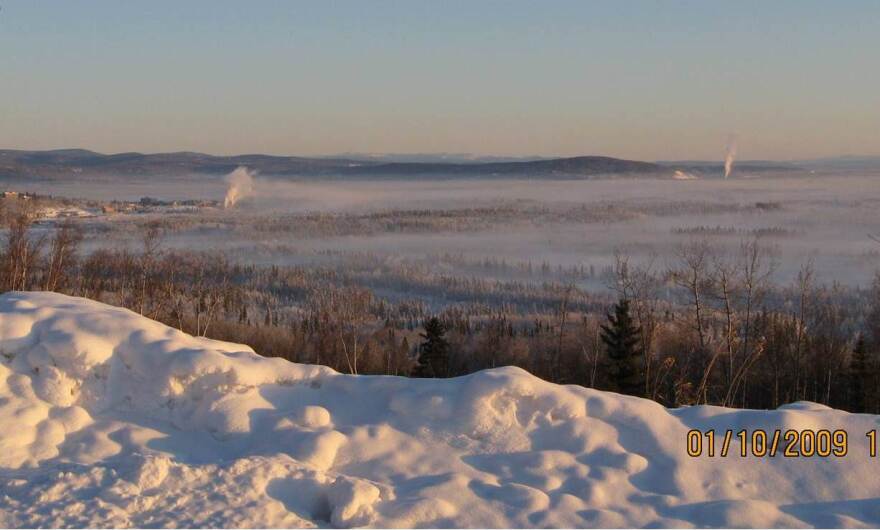The controversial air-quality regulations that state officials have proposed for the Fairbanks-area residents are aimed at reducing pollution from wood-burning heating systems. They do not apply to coal-fired systems, which are becoming increasingly popular because coal is even cheaper than wood. That worries local and state officials, because burning coal releases many of the same pollutants as wood.
Business is brisk at North Pole Coal. It’s the Interior’s biggest distributor of coal and the devices that burn the stuff to heat homes and businesses. Like the commercial-scale boiler that Co-owner Ron Muir was showing off Wednesday.
Muir says his business has been growing by an average of 25 percent per year since he began selling coal about five years ago. That’s about when the price of heating oil began to skyrocket. He’s now selling about 50 tons per year throughout the Interior.
Muir says his customer base is growing rapidly because people are finding out how much cheaper it is to heat with coal than any other fuel in this area – including firewood.
“It cut our fuel bill by 75 percent here at the shop,” he said.
Muir says if you compare the cost of coal versus heating oil, based on the amount of BTUs that each produces, he’s heating his big shop for the equivalent of one-dollar-a-gallon oil.
Kent Severns, who owns The Woodway, a store that specialized in wood-burning stoves, also has heard a lot of interest in coal from his customers over the years, especially in recent years. Severns thinks that’s partly because coal is so cheap. But he also suspects that the word is getting around that the proposed state air-qualities regulations don’t affect coal-burning systems.
“We’ve definitely had more interest” expressed by customers, he said. “And especially since the current regulations stuff has kind of tweaked people’s interest in that. And the regulations – and that’s one of my concerns – is that the regulations indicate coal’s not going to be regulated, wood is, I’m going to go with coal.”
It’s almost true that the new regs don’t pertain to coal, says Alice Edwards. She’s the head of the state Division of Air Quality who’s overseeing development of the air-quality regulations. Edwards says the regs do make one reference to coal-burning units.
“It would require that people that are using coal stoves actually burn coal in their coal stoves,” she said.
Edwards says the proposed regs don’t apply to coal heating mainly because surveys taken over the past few years suggest there aren’t that many people burning coal in this area. Less than 5 percent of the households in the most recent survey, from 2010, said they used coal.
“Our focus at this point has been primarily on the largest source of wood-fired heaters,” she said.
Critics say the surveys reflect an unrealistically low number due to unverifiable voluntary responses. Edwards says her agency is conducting another survey.
She says the state regs also don’t address residential and commercial coal-fired heating systems because the federal government hasn’t set standards for them.
Jim Conner, who heads up the Fairbanks North Star Borough Air Quality Division, says the state should develop its own set of coal-heating emission standards. Conner says that’s because it’s clear that coal is becoming more popular, especially around North Pole. And he says that’s contributing to the area’s air-quality problems – and will even more so in the coming years.
“What I’m getting reported back to me on a daily basis is that there are more and more of these coal-burning units that keep popping up,” Conner said. “And the reason they notice them is because of the odor and particulates. And we are concerned about them because of the low cost of coal people will move to this source of fuel out of necessity.”
But Edwards says it’s unlikely that the state will develop its own coal-heating emission standards. She says that’s a big undertaking, and that’s why states generally leave it to the feds. And given the likelihood of state budget cuts, now is not a good time for such as project.
Edwards agrees the use of coal for heat in this area is increasing, and that it is aggravating the area’s air pollution problem. She says the state agency will keep an eye on the situation.
“We’re continuing to look at the situation with coal-fired heating devices,” she said, “and are certainly open to peoples’ thoughts and comments on this issue. And looking at things that we might able to do to address emissions from resitnial coal-fired devices, particularly if they become a bigger source within the community.”
Muir, the North Pole Coal proprietor, says he thinks the problem will diminish as more coal customers buy higher-efficiency systems like the ones he sells.
In any case, he believes coal will likely continue to be a growth industry here in the Interior.



